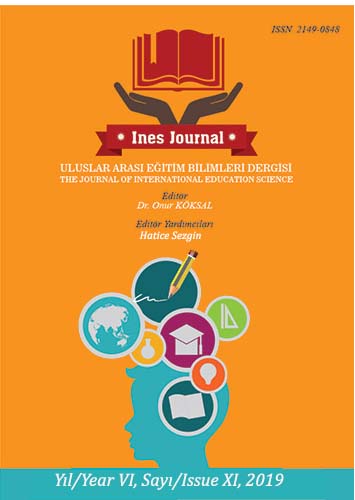Author :
Abstract
Bu çalışmada, Adnan Menderes Üniversitesi’nin 5(I) dersleri kapsamındaki Türk Dili ve Edebiyatı derslerinin uzaktan eğitim ile verilmesinin öğrencilerin başarıları üzerindeki etkisinin incelenmesi amaçlanmıştır. Araştırmaya dahil olan öğrencilerin uzaktan eğitime yönelik algılarının cinsiyet, öğrenim türü, uyruk, ders içeriklerine ulaşma yolları, kişisel bilgisayara sahip olma durumları ve internete bağlanma durumlarına göre farklılık oluşturma durumlarına bakılmıştır. Araştırma sonuçlarına göre öğrencilerin cinsiyetlerine ve öğrenim türlerine göre “İçerik” ve “Genel Değerlendirme” algı düzeylerinde istatistiksel olarak anlamlı bir farklılık oluşmadığı, “Sunum Kalitesi” algı düzeylerinde ise anlamlı farklılık oluştuğu sonucuna ulaşılmıştır. Kız öğrencilerin erkek öğrencilere oranla 5(I) derslerinin sunum kalitesini daha nitelikli buldukları görülmüştür. “Normal Öğretim” öğrencilerin, “İkinci Öğretim” öğrencilerine göre 5(I) ile ilgili sunumları daha nitelikli buldukları belirlenmiştir. Öğrencilerin uyruklarına göre “Sunum Kalitesi” ile ilgili değerlendirmeleri arasında istatistiksel anlamlı bir farklılık bulunmamışken, “İçerik” ve “Genel Değerlendirme” düzeyleri arasında ise istatistiksel olarak anlamlı bir farklılık olduğu belirlenmiştir. Buna göre “Yabancı” uyruklu öğrencilerin, “Yerli” öğrencilere göre 5(I) ile ilgili sunumları daha kaliteli ve doyurucu nitelikte buldukları söylenebilir. Elde edilen analiz sonuçlarına göre, öğrencilerin kişisel bilgisayara ve internet erişimine sahip olma durumlarının 5(I) derslerinin “İçerik”, “Sunum Kalitesi” ve “Genel Değerlendirme” düzeylerini anlamlı bir şekilde yordamaktadır.
Keywords
Abstract
In this study, it is aimed to examine the effect of giving Turkish Language and Literature courses within the scope of 5 (I) courses of Adnan Menderes University with distance education on students' achievements. Students' perceptions of distance education were examined according to gender, type of education, nationality, ways of accessing course contents, having a personal computer and making a difference according to their internet connection status. According to the results of the research, it was concluded that there was no statistically significant difference in perception levels of “Content” and Değerlendirme General Evaluation, according to gender and type of education, but there was a significant difference in “Presentation Quality” perception levels. It was observed that female students found the quality of presentation of 5 (I) courses to be more qualified than men. It was determined that “Normal Education” students found presentations about 5 (I) more qualified than “Secondary Education” students. While there was no statistically significant difference between the evaluations of students regarding “Quality of Presentation göre according to their nationalities, there was a statistically significant difference between“ Content ”and“ General Evaluation ”levels. According to this, it is seen that “Foreign” students find presentations about 5 (I) more quality and satisfying than göre Native ”students. According to the results of the analysis, it was concluded that the students' having a personal computer and internet access significantly predicted “Content”, “Presentation Quality” and “General Evaluation inin levels of 5 (I) courses.
Keywords
- Adams, A. & Timmis, F. (2006). Students views of integrating web-based learning tecnology into the nursing cirriculum-a descriptive survey. Nurse Education in Practice, 6, 2-21.
- Adıyaman, Z. (2002). Uzaktan eğitim yoluyla yabancı dil öğretimi. The Turkish Online Journal of Educational Technology TOJET, 1(11), 92-97.
- Altıparmak, M., Kurt, İ. D. ve Kapıdere, M. (2011). E-Öğrenme ve uzaktan eğitimde açık kaynak kodlu öğrenme yönetim sistemleri. Akademik Bilişim, Malatya: Akademik Bilişim Konferansı Bildirileri, 319-327.
- Ateş, A. ve Altun, E. (2008). Bilgisayar öğretmeni adaylarının uzaktan eğitime yönelik tutumlarının çeşitli değişkenler açısından incelenmesi. Gazi Eğitim Fakültesi Dergisi, 28(3), 125-145.
- Bates, AT (2005). Teknoloji, e-öğrenme ve uzaktan eğitim. London and New York: Routledge.
- Bontempi, E. & Warden-Hazlewood, L. (2003). Factors in effective computer-assisted instruction. Online Learning, 1, 1–7.
- Büyüköztürk, Ş. (2002). Sosyal bilimler için veri analizi el kitabı. Ankara: Pegem Akademik Yayıncılık.
- Çetin, Ö., Çakıroğlu, M., Bayılmış, C. ve Ekiz, H. (2004). Teknolojik gelişme için eğitimin önemi ve internet destekli öğretimin eğitimdeki yeri. The Turkish Online Journal of Educational Technology – TOJET, 3(3), 144-147.
- Düzakın, E. ve Yalçınkaya, S. (2008). Web tabanlı uzaktan eğitim sistemi ve Çukurova Üniversitesi öğretim elemanlarının yatkınlıkları. Çukurova Üniversitesi Sosyal Bilimler Enstitüsü Dergisi, 17(1), 225-244.
- Ekiz, H., Bayam, Y. ve Ünal, H. (2003). Mantık devreleri dersine yönelik internet destekli uzaktan eğitim uygulaması. The Turkish Online Journal of Educational Technology – TOJET, 2(4), 92-99.
- Gündüz, A. Y. (2013). Öğretmen adaylarının uzaktan eğitim algısı. (Yayınlanmamış Yüksek Lisnas Tezi), Sakarya Üniversitesi Eğitim Bilimleri Enstitüsü, Sakarya.
- Karasar, N. (2012). Bilimsel araştırma yöntemi. 20. Baskı, Ankara: Nobel Yayın Dağıtım.
- Odabaş, H. (2003). Internet tabanlı uzaktan eğitim ve bilgi ve belge yönetimi bölümleri. Türk Kütüphaneciliği, 17(1), 22-36.
- Salyers, V., Carter, L., Barrett, P., & Williams, L. (2010). Evaluating student and faculty satisfaction with a pedagogical framework, The Journal of Distance Education, 24(3).
- Sinecen, M. (2010). Uzaktan Eğitim’de Moodle kullanımı ve kurulumu. Akademik Dizayn Dergisi, 1, 14-21.
- Soydal, İ., Alır, G. ve Ünal, Y. (2012). Türk üniversiteleri e-öğrenmeye hazır mı? Hacettepe Üniversitesi Edebiyat Fakültesi örneği. International Conference on Electronic Publishing, ELPUB, 133-144.
- Şen, B., Atasoy, F., Aydın, ve Nesrin. (2010). Düşük maliyetli web tabanlı uzaktan eğitim sistemi. Akademik Bilişim, Muğla: Akademik Bilişim Konferans Bildirileri.
- Umut, A.L. ve Madran, O. R. (2004). Web tabanlı uzaktan eğitim sistemleri: sahip olması gereken özellikler ve standartlar. Bilgi Dünyası, 5(2), 259-271.
- Ünalır E., Önal A. ve Beydağ Ü. (2006). Bilgisayar teknolojileri dersi alan öğrencilerin uzaktan eğitim programlarına bakış açıları. Akademik Bilişim, Pamukkale Üniversitesi, Denizli.
- Yakın, İ. ve Tınmaz, H. (2013). Uzaktan eğitimde önemli bir boyut: Öğretmen adaylarının e- hazırbulunuşlukları. XIV. Akademik Bilişim Konferansı, Akdeniz Üniversitesi, Antalya.





